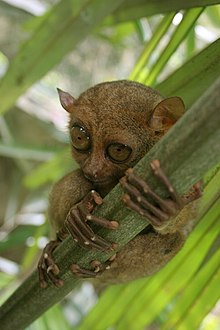
Back رسغيات Arabic ابخص ARZ Pincol (Tarsiidae) AVK Uzuntopuqlar Azerbaijani Tarsier BCL Даўгапяткавыя BE-X-OLD Tarsers Catalan Tarsiidae CEB Nártounovití Czech Tarsier Welsh
| Tarsiers[1][2] Temporal range: Middle Eocene to Recent
| |
|---|---|

| |
| Philippine tarsier (Carlito syrichta) | |
| Scientific classification | |
| Domain: | Eukaryota |
| Kingdom: | Animalia |
| Phylum: | Chordata |
| Class: | Mammalia |
| Order: | Primates |
| Suborder: | Haplorhini |
| Infraorder: | Tarsiiformes |
| Family: | Tarsiidae Gray, 1825 |
| Type genus | |
| Tarsius Storr, 1780
| |
| Genera | |
Tarsiers (/ˈtɑːrsiərz/ TAR-see-ərz) are haplorhine primates of the family Tarsiidae, which is, itself, the lone extant family within the infraorder Tarsiiformes. Although the group was, prehistorically, more globally widespread, all of the species living today are restricted to Maritime Southeast Asia, predominantly being found in Brunei, Indonesia, Malaysia and the Philippines.[3]

They are found primarily in forested habitats, especially forests that have liana, since the vine gives tarsiers vertical support when climbing trees.[4]
- ^ Groves, C. P. (2005). Wilson, D. E.; Reeder, D. M. (eds.). Mammal Species of the World: A Taxonomic and Geographic Reference (3rd ed.). Baltimore: Johns Hopkins University Press. pp. 127–128. ISBN 0-801-88221-4. OCLC 62265494.
- ^ Cite error: The named reference
2010_Groves_Shekellewas invoked but never defined (see the help page). - ^ The Editors of Encyclopædia Britannica. “Tarsier.” Encyclopædia Britannica, Encyclopædia Britannica, Inc., 14 Apr. 2019, http://www.britannica.com/animal/tarsier.
- ^ Simeon, S.G.F.; Duya, M.R.M; Duya, M.V.; Galindon, J.M.M.; Pasion, B.O.; Ong, P.S. (2020). "Living in small spaces: Forest fragment characterization and its use by Philippine tarsiers (Tarsius syrichta Linnaeus, 1758) in Mindanao Island, Philippines". Primates. 61 (3): 529–542. doi:10.1007/s10329-020-00798-2. PMID 32043166. S2CID 211075031.
© MMXXIII Rich X Search. We shall prevail. All rights reserved. Rich X Search